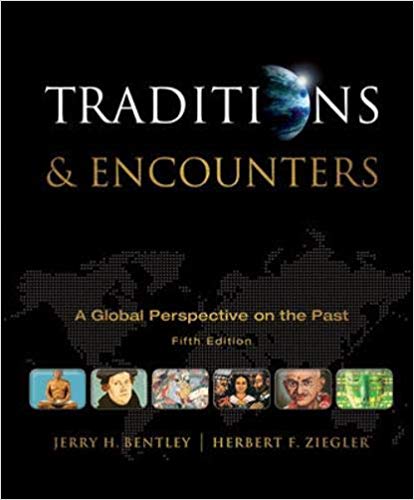Description
Traditions & Encounters A Global Perspective on the Past 5th Edition by Jerry Bentley – Test Bank
Chapter 3
Early African Societies and the Bantu Migrations
MULTIPLE CHOICE
1. Which of the following societies began the custom of embalming to preserve the body for its life after death?
a. Egypt
b. Mesopotamia
c. India
d. China
e. Persia
Answer: a
Page: 49
2. Around ________ B.C.E., peoples of the eastern Sudan started to domesticate cattle and became nomadic herders.
a. 25,000
b. 18,000
c. 9000
d. 4000
e. 1500
Answer: c
Page: 50-51
3. The early Sudanic societies recognized a single divine force as the source of good and evil, and they associated it with
a. fire.
b. the ocean.
c. the sun.
d. rain.
e. the moon.
Answer: d
Page: 51
4. The Greek historian Herodotus used the phrase “the gift of the ________” to describe Egypt.
a. Indus
b. Huang He
c. Nile
d. Tigris
e. Issus
Answer: c
Page: 52
5. The earliest Egyptian and Nubian states were
a. city-states.
b. small kingdoms.
c. centralized empires.
d. trading networks.
e. unified early because of the unique nature of the Tigris.
Answer: b
Page: 52
6. Egypt was united around 3100 B.C.E. by the conqueror
a. Menes.
b. Khufu.
c. Sargon of Akkad.
d. Hatshepsut.
e. Hammurabi.
Answer: a
Page: 52
7. The largest Egyptian pyramids were built during the
a. Middle Kingdom.
b. Old Kingdom.
c. New Kingdom.
d. Archaic Period.
e. Second Intermediary Period.
Answer: b
Page: 53
8. ________’s is the largest of all the pyramids.
a. Sargon of Akkad
b. Khufu
c. Hyksos
d. Menes
e. Giza
Answer: b
Page: 53
9. The capital of the kingdom of Kush was
a. Kerma.
b. Axum.
c. Memphis.
d. Harappa.
e. Harkhuf.
Answer: a
Page: 53
10. Harkhuf was
a. the capital of Kush.
b. the most powerful pharaoh of the Old Kingdom.
c. an Egyptian explorer who visited Nubia.
d. the largest Middle Kingdom pyramid.
e. the first woman pharaoh.
Answer: c
Page: 54
11. Pharaohs in the New Kingdom were
a. more powerful than pharaohs of the Old Kingdom.
b. descended from a line of Babylonian kings.
c. set on the throne by the Roman emperor Julius Caesar.
d. more vigorous in their attempts to extend Egyptian authority beyond the Nile valley and delta.
e. sacrificed at age thirty-two to insure a bountiful harvest.
Answer: d
Page: 55
12. Around 3100 B.C.E., the conqueror Menes founded ________, a city that would serve as the capital for early Egypt.
a. Heliopolis
b. Kerma
c. Uruk
d. Memphis
e. Thebes
Answer: d
Page: 57
13. The Hyksos were
a. nomads who eventually settled around the city of Babylon.
b. external invaders who helped bring about the end of the Egyptian Middle Kingdom.
c. Mesopotamian kings.
d. the priestly class in ancient Egypt.
e. demons who punished the wicked in the Egyptian underworld.
Answer: b
Page: 54-55
14. Horse-drawn chariots and bronze weapons were introduced into Egypt by the
a. Hyksos.
b. Babylonians.
c. Kushites.
d. Harappans.
e. Qin.
Answer: a
Page: 54-55
15. The most vigorous of all New Kingdom pharaohs was ________, who led his troops into Palestine and Syria and who even received tribute from the Mesopotamian city-states.
a. Ahmose I
b. Menes
c. Sargon of Akkad
d. Tuthmosis III
e. Hatshepsut
Answer: d
Page: 55
16. The Egyptians were the most imperialistic during the
a. First Intermediary Period.
b. Archaic Period.
c. New Kingdom.
d. Old Kingdom.
e. Middle Kingdom.
Answer: c
Page: 55
17. During the eighth century B.C.E., Egypt fell under the control of the ________ for around a century.
a. Persians
b. Romans
c. Greeks
d. Babylonians
e. Kushites
Answer: e
Page: 56
18. Around 760 B.C.E. the Kushite king Kashta
a. officially converted to the Egyptian gods.
b. founded a dynasty that ruled Egypt for around a hundred years.
c. formed a long-lasting trading agreement with Egypt, marking their first contact.
d. surrendered to Assyrian domination.
e. surrendered to Egyptian domination.
Answer: b
Page: 56
19. In the mid-seventh century B.C.E. Egypt lost its independence and became a part of
a. the Assyrian empire.
b. the Arabic empire.
c. the Persian empire.
d. the Roman empire.
e. the Harappan empire.
Answer: a
Page: 57
20. Hatshepsut was
a. a Mesopotamian king of the gods.
b. the Hebrew term for their god.
c. the first conqueror to unite all of Mesopotamia.
d. a woman who ruled Egypt as pharaoh.
e. the most important early city of the Harappan society.
Answer: d
Page: 59





Be the first to review “Traditions & Encounters A Global Perspective on the Past 5th Edition by Jerry Bentley – Test Bank”